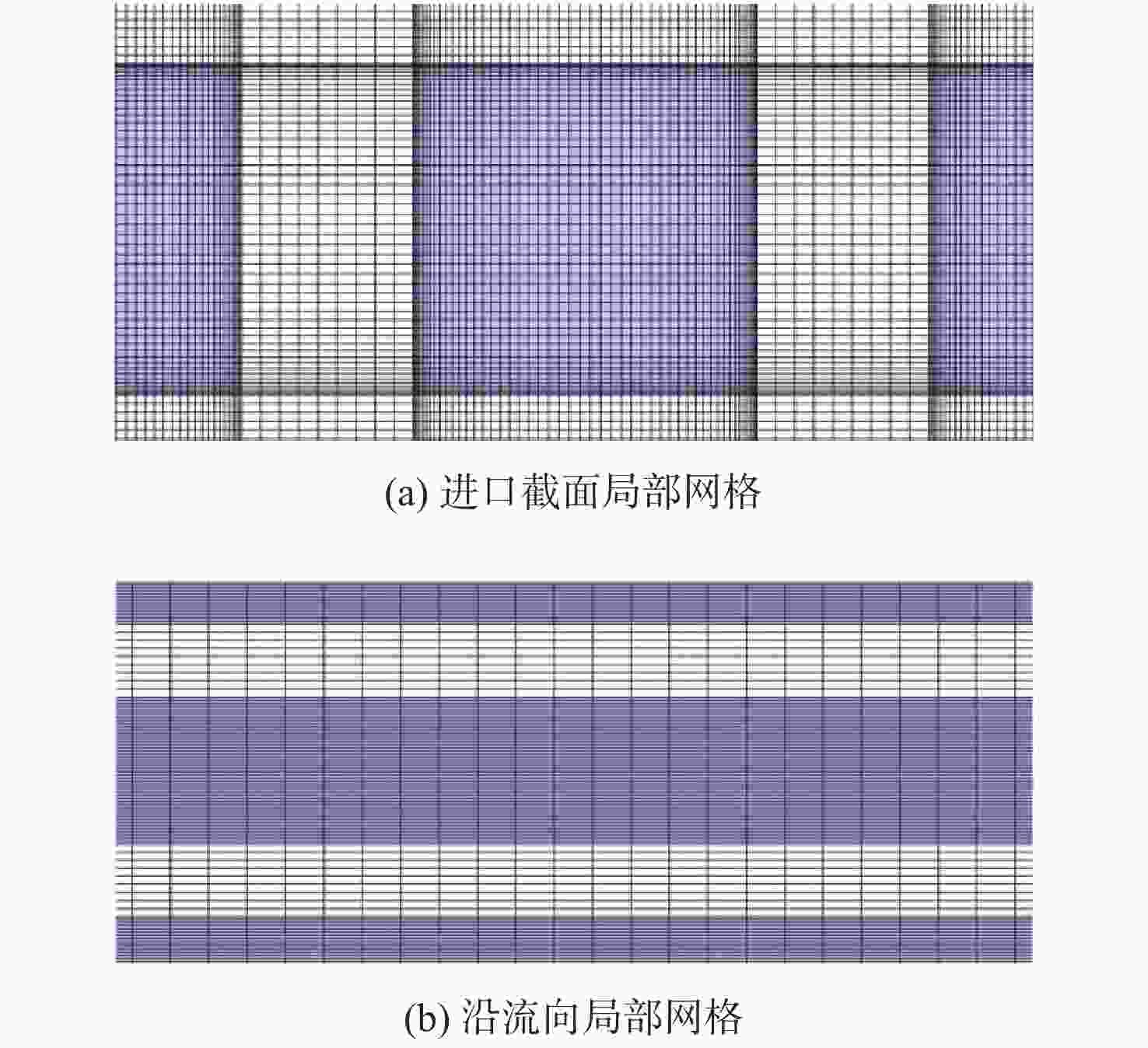Study on heat transfer of combustor and regenerative cooling channel based on two-way coupling
-
摘要:
为研究超燃冲压发动机燃烧室与再生冷却通道的耦合传热特性,采用双向弱耦合迭代计算方法,研究燃烧室和冷却通道的特征参数对耦合传热特性的影响规律。结果表明:当量比的增加导致燃烧反应区域和壁面高温区域后移,当量比增大至0.75时,部分壁面高温区后移至超出燃烧段范围,在燃烧室的当量比设计时需考虑冷却通道范围的限制;喷射角度的增大会提高燃烧段壁面平均温度,喷射角度由30°增大到75°时,冷却通道出口裂解率由8%增长到11%;增大冷却剂的工作压力和流量能增强冷却剂的吸热能力,降低燃烧室内壁面温度,最大下降幅度约200 K。
Abstract:In order to investigate the heat transfer characteristics of regenerative cooling channels and scramjet combustors, a two-way weak-coupling iterative calculation method is adopted. The combustor settings and cooling channel impacts on heat transfer and N-decane pyrolysis were studied numerically using this information. The findings indicate that the burning region and the high-temperature area will move rearward when the equivalency ratio increases. When the equivalence ratio reaches 0.75, part of the high-temperature zone moves out of the combustion section and the cooling channel cannot effectively cool the combustor. Therefore, the limitation of cooling channel should be considered in the design of equivalence ratio of the combustor. Moreover, a larger fuel injection angle leads to an ascent of the average temperature of the wall. The cracking rate at the outlet of the cooling channel increases from 8% to 11% as the injection angle increases from 30° to 75°. The combustor's temperature can drop by up to 200 K as a result of improving the coolant's heat absorption capacity through increased operating pressure in the cooling channel and coolant flow.
-
Key words:
- scramjet /
- combustor /
- regenerative cooling /
- coupling heat transfer /
- numerical study
-
表 1 燃烧室和冷却通道边界条件
Table 1. Boundary conditions of combustor and cooling channel
工况 当量比 喷射角度/(°) 冷却通道压力/MPa 冷却剂流量/(kg·s−1) 1 0.15,0.35,0.55,0.75 90 3 0.045 2 0.15 30,45,60,75 3 0.045 3 0.7 90 3,4,5,6 0.045 4 1 90 3 0.035,0.045,0.055,0.065 表 2 冷却通道出口温度和正癸烷质量分数
Table 2. The temperature and N-decane mass fraction of cooling channel outlet
耦合方式 平均温度/K 正癸烷质量分数 单向耦合 544.93 0.919 8 双向耦合 558.69 0.891 3 -
[1] 张丽静, 刘东升, 于存贵, 等. 高超声速飞行器[J]. 航空兵器, 2010, 17(2): 13-16. doi: 10.3969/j.issn.1673-5048.2010.02.003ZHANG L J, LIU D S, YU C G, et al. Hypersonic aircraft[J]. Aero Weaponry, 2010, 17(2): 13-16(in Chinese). doi: 10.3969/j.issn.1673-5048.2010.02.003 [2] 王振国, 梁剑寒, 丁猛, 等. 高超声速飞行器动力系统研究进展[J]. 力学进展, 2009, 39(6): 716-739. doi: 10.3321/j.issn:1000-0992.2009.06.011WANG Z G, LIANG J H, DING M, et al. A review on hypersonic airbreathing propulsion system[J]. Advances in Mechanics, 2009, 39(6): 716-739(in Chinese). doi: 10.3321/j.issn:1000-0992.2009.06.011 [3] 刘世俭, 刘兴洲. 超燃冲压发动机可贮存碳氢燃料再生主动冷却换热过程分析[J]. 飞航导弹, 2009(3): 48-52.LIU S J, LIU X Z. Analysis of regenerative active cooling heat transfer process of storable hydrocarbon fuel in scramjet[J]. Winged Missiles Journal, 2009(3): 48-52(in Chinese). [4] 张泰昌, 王晶, 范学军. 主动冷却超燃冲压发动机燃烧室内流道设计[C]//高超声速专题研讨会暨第五届全国高超声速科学技术会议论文集. 北京: 中国力学学会, 2012.ZHANG T C, WANG J, FAN X J. Design of flow passage in combustion chamber of active cooling scramjet[C]//Proceedings of Hypersonic Symposium and the Fifth National Hypersonic Science and Technology Conference. Beijing: Chinese Society of Theoretical and Applied Mechanics, 2012(in Chinese). [5] 李俊红, 潘宏禄, 沈清, 等. 超燃冲压发动机燃烧室的燃烧特性[J]. 航空动力学报, 2014, 29(1): 14-22.LI J H, PAN H L, SHEN Q, et al. Combustion characteristics of scramjet combustor[J]. Journal of Aerospace Power, 2014, 29(1): 14-22(in Chinese). [6] 纪鹏飞, 徐旭, 陈兵, 等. 双支板超燃冲压发动机燃烧特性研究[J]. 北京航空航天大学学报, 2017, 43(2): 366-374.JI P F, XU X, CHEN B, et al. Combustion performance investigation of a dual-struts scramjet[J]. Journal of Beijing University of Aeronautics and Astronautics, 2017, 43(2): 366-374(in Chinese). [7] FROELICH A, IMMICH H, LEBAIL F, et al. Three-dimensional flow analysis in a rocket engine coolant channel of high depth/width ratio[C]//Proceedings of the 27th Joint Propulsion Conference. Reston: AIAA, 1991. [8] 牛禄. 液体火箭发动机层板再生冷却技术研究[D]. 上海: 上海交通大学, 2002: 84-102.NIU L. Study on regenerative cooling technology of liquid rocket engine laminate[D]. Shanghai: Shanghai Jiao Tong University, 2002: 84-102(in Chinese). [9] 李军伟, 刘宇. 一种计算再生冷却推力室温度场的方法[J]. 航空动力学报, 2004, 19(4): 550-556. doi: 10.3969/j.issn.1000-8055.2004.04.022LI J W, LIU Y. Method of computing temperature field in regeneratively-cooled thrust chamber[J]. Journal of Aerospace Power, 2004, 19(4): 550-556(in Chinese). doi: 10.3969/j.issn.1000-8055.2004.04.022 [10] LU Y, WANG X Z, LI L, et al. Development and preliminary validation of a thermal analysis method for hydrocarbon regenerative-cooled supersonic combustor[C]//Proceedings of the 20th AIAA International Space Planes and Hypersonic Systems and Technologies Conference. Reston: AIAA, 2015: AIAA2015-355. [11] MA J C, CHANG J T, ZHANG J L, et al. Control-oriented unsteady one-dimensional model for a hydrocarbon regeneratively-cooled scramjet engine[J]. Aerospace Science and Technology, 2019, 85: 158-170. doi: 10.1016/j.ast.2018.12.012 [12] 王新竹, 张泰昌, 陆阳, 等. 主动冷却燃烧室燃烧与传热耦合过程迭代分析设计方法[J]. 推进技术, 2014, 35(2): 213-219.WANG X Z, ZHANG T C, LU Y, et al. An iterative analysis and design method for study of coupling processes of combustion and heat transfer in actively-cooled scramjet combustor[J]. Journal of Propulsion Technology, 2014, 35(2): 213-219(in Chinese). [13] ODAM J. Scramjet experiments using radical farming[D]. Brisbane: The University of Queensland, 2004: 5-10. [14] WARD T A, ERVIN J S, STRIEBICH R C, et al. Simulations of flowing mildly-cracked normal alkanes incorporating proportional product distributions[J]. Journal of Propulsion and Power, 2004, 20(3): 394-402. doi: 10.2514/1.10380 [15] WARD T A, ERVIN J S, ZABARNICK S, et al. Pressure effects on flowing mildly-cracked n-decane[J]. Journal of Propulsion and Power, 2005, 21(2): 344-355. doi: 10.2514/1.6863 [16] YOUNGLOVE B A, ELY J F. Thermophysical properties of fluids. II. Methane, ethane, propane, isobutane, and normal butane[J]. Journal of Physical and Chemical Reference Data, 1987, 16(4): 577-798. doi: 10.1063/1.555785 [17] MILLAT J, DYMOND J H, NIETO DE CASTRO C A. Transport properties of fluids: Their correlation, prediction and estimation[M]. Cambridge: Cambridge University Press, 1996: 325-430. [18] Huber M L. NIST thermophysical properties of hydrocarbon mixtures database (SUPERTRAPP)[EB/OL] . (2003-01-11) [2022-01-15].https://webbook.nist.gov/chemistry/form-ser/. [19] 戎毅, 朱剑琴, 戴武昊, 等. 超燃冲压发动机冷却通道与燃烧室耦合传热数值研究[J]. 推进技术, 2022, 43(4): 168-177.RONG Y, ZHU J Q, DAI W H, et al. Numerical study on coupled heat transfer between cooling channel and combustor of scramjet[J]. Journal of Propulsion Technology, 2022, 43(4): 168-177(in Chinese). [20] 吴坤, 范学军. 超声速燃烧数值模拟中复杂化学反应的建模方法[J]. 空气动力学学报, 2020, 38(3): 552-576.WU K, FAN X J. Modeling methodology for complex chemical mechanism involved in supersonic combustion simulation[J]. Acta Aerodynamica Sinica, 2020, 38(3): 552-576(in Chinese). [21] SABELNIKOV V, FUREBY C. LES combustion modeling for high Re flames using a multi-phase analogy[J]. Combustion and Flame, 2013, 160(1): 83-96. doi: 10.1016/j.combustflame.2012.09.008 [22] 范学军, 俞刚. 超临界煤油超声速燃烧特性实验[J]. 推进技术, 2006, 27(1): 79-82.FAN X J, YU G. Experiments on supersonic combustion of supercritical kerosene[J]. Journal of Propulsion Technology, 2006, 27(1): 79-82(in Chinese). [23] ALFF F, BRUMMUND U, CLAUSS W, et al. Experimental investigation of the combustion process in a supersonic combustion ramjet (SCRAMJET) combustion chamber[C]//Proceedings of the Annual Conference, German Aerospace Congress. Erlangen: DGLR, 1994. [24] JACHIMOWSKI C J. Analytical study of the hydrogen-air reaction mechanism with application to scramjet combustion: NASA-TP-2791 [R]. Washton, D. C. : NASA , 1988, 2791-2807. [25] GNIELINSKI V. New equations for heat and mass transfer in turbulent pipe and channel flow[J]. Engineering, 1975, 41(1): 8-16. [26] 李锋, 吕付国, 罗卫东, 等. 超声速气流中液体横向射流的破碎特性[J]. 北京航空航天大学学报, 2015, 41(12): 2356-2362.LI F, LYU F G, LUO W D, et al. Breakup characteristics of liquid jet in supersonic cross flow[J]. Journal of Beijing University of Aeronautics and Astronautics, 2015, 41(12): 2356-2362(in Chinese). -







 下载:
下载:






























